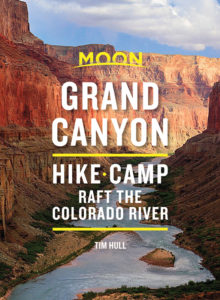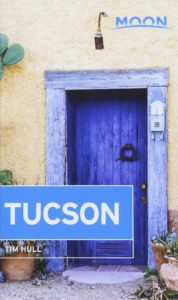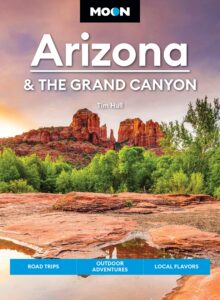Tucson
The fastest way across Tucson is I-10, which runs diagonally along the western and southern edges of the city. Some of the more interesting “old road” routes around town include the Miracle Mile, north of downtown, and 6th Avenue, the main highway before the interstate was built.
South of Tucson, 6th Avenue becomes the Old Nogales Highway, the old road to Mexico, which veers in various alignments among extensive pecan groves while crisscrossing I-19.
Though it’s less than half the size of Phoenix, Tucson (pop. 545,975) is perhaps twice as nice a place to visit. With a lively university community, some of the most beautiful desert landscapes anywhere on earth, and more palpable history than anywhere in the Southwest outside of New Mexico, Tucson is well worth taking the time to get to know. It also makes an excellent jumping-off point for visiting the Wild West towns of Tombstone and Bisbee in the state’s southeast corner.
However, with daytime temperatures averaging over 100°F, Tucson is hotter than heck during the summer months (early May-late Sept.), so try to visit during the rest of the year. Spring is especially nice, with wildflowers blooming and spring training baseball bashing away, but this is also the most expensive time to be here—room rates in March are easily double those the rest of the year.
Many of Tucson’s biggest attractions are outside the city limits and covered under various road trips: Biosphere 2 and Mission San Xavier del Bac are north and south of Tucson along US-93, while the two-part Saguaro National Park is east and west of downtown (and covered with the US-80 Southern Pacific route). But unlike many modern desert cities, downtown Tucson is worth a wander for the many historic buildings that have been spared the redeveloper’s wrecking ball, including a wonderfully restored Roaring 1920s movie palace, the Fox Tucson Theatre on Congress Street, which has frequent movies and great live concerts.
The other center of activity is 2 mi (3.2 km) north and east from downtown, where the nicely landscaped 392-ac (159-ha) University of Arizona campus spreads between Speedway Boulevard and 6th Street. The campus holds the engaging historical exhibits of the Arizona State Museum (520/621-6302, Mon.-Sat., $5) and one of the country’s preeminent photography collections in the Center for Creative Photography (1030 N. Olive Rd., 520/621-7968, donation).
On the southeast side of Tucson, off I-10 at the Kolb Road exit, Davis-Monthan Air Force Base holds one of the strangest sights in the entire Southwest desert: rows and rows and rows of surplus military aircraft, lined up for what seems like miles. The official name for this desert facility is the Aerospace Maintenance and Regeneration Group (AMARG), but it’s best known as The Boneyard because of its role as a salvage yard for aircraft long past their production era. You can glimpse dozens of the planes from the highway, but for the full experience you have to sign up for one of the popular tours (520/574-0462, Mon.-Fri., $15 and up, reservations required 16 days in advance). The tours are offered by the Pima Air and Space Museum, which has another extensive exhibit of aircraft, including JFK’s Air Force One, nearby, and also operates the unique Titan Missile Museum south of Tucson.
The foothills of the Santa Catalina Mountains, which rise north of Tucson, are blessed by Sabino Canyon (520/749-8700, daily), 14 mi (22.5 km) east of downtown (take Tanque Verde Road to Sabino Canyon Road). With its seasonal waterfalls and a nearly year-round creek, Sabino Canyon is a great place to stretch your legs while getting a sense of how pretty and vibrant the desert can be.
West of Tucson, beyond where Speedway Boulevard climbs over Gates Pass, Tucson Mountain is home to a section of Saguaro National Park and the excellent Arizona Sonora Desert Museum (520/883-2702, daily, $22). Apart from spending a lifetime in the desert, there’s no better place to get a sense of the abundant flora and fauna of the Sonoran Desert than this creatively presented zoological park.
Where to Eat and Stay in Tucson
The main I-10 freeway runs diagonally from northwest to southeast along the usually dry Santa Cruz River at the western edge of town. Tucson stretches east from here for more than 10 mi (16 km), and north toward the foothills of the Santa Catalina Mountains. The main east-west route across town is Speedway Boulevard, along with numerous parallel roads.
In addition to the usual highway motels, Tucson has some characterful places to stay, from restored downtown hotels to luxurious vacation resorts. One of the latter is the Hacienda del Sol (5501 N. Hacienda del Sol Rd., 520/299-1501, $279 and up), a historic guest ranch built as a posh girls’ school in the 1920s and now a quiet, intimate getaway with a pool, great sunset views, and one of Tucson’s best restaurants (The Grill). Another historic property, the Arizona Inn (2200 E. Elm St., 520/325-1541 or 800/933-1093, $359 and up), is perhaps the classic Arizona resort, little changed since the 1930s, when it was a favorite winter haunt of the Rockefellers and other elites. The Arizona Inn offers comfortable accommodations on lovingly landscaped grounds near the university campus.
An enjoyable place to eat breakfast or lunch in Tucson is The Little One (151 N. Stone St.), which offers adventurously creative Mexican food. Try anything in a mole sauce, and you won’t be disappointed. On the west side of downtown, El Charro Café (311 N. Court Ave., 520/622-1922) is “the oldest family-operated Mexican restaurant in the USA,” so they say, serving up inexpensive food and margaritas since 1922 in a turn-of-the-20th-century house.
Related Travel Guides
Travel Map of the Border to Border Route Through Arizona

















